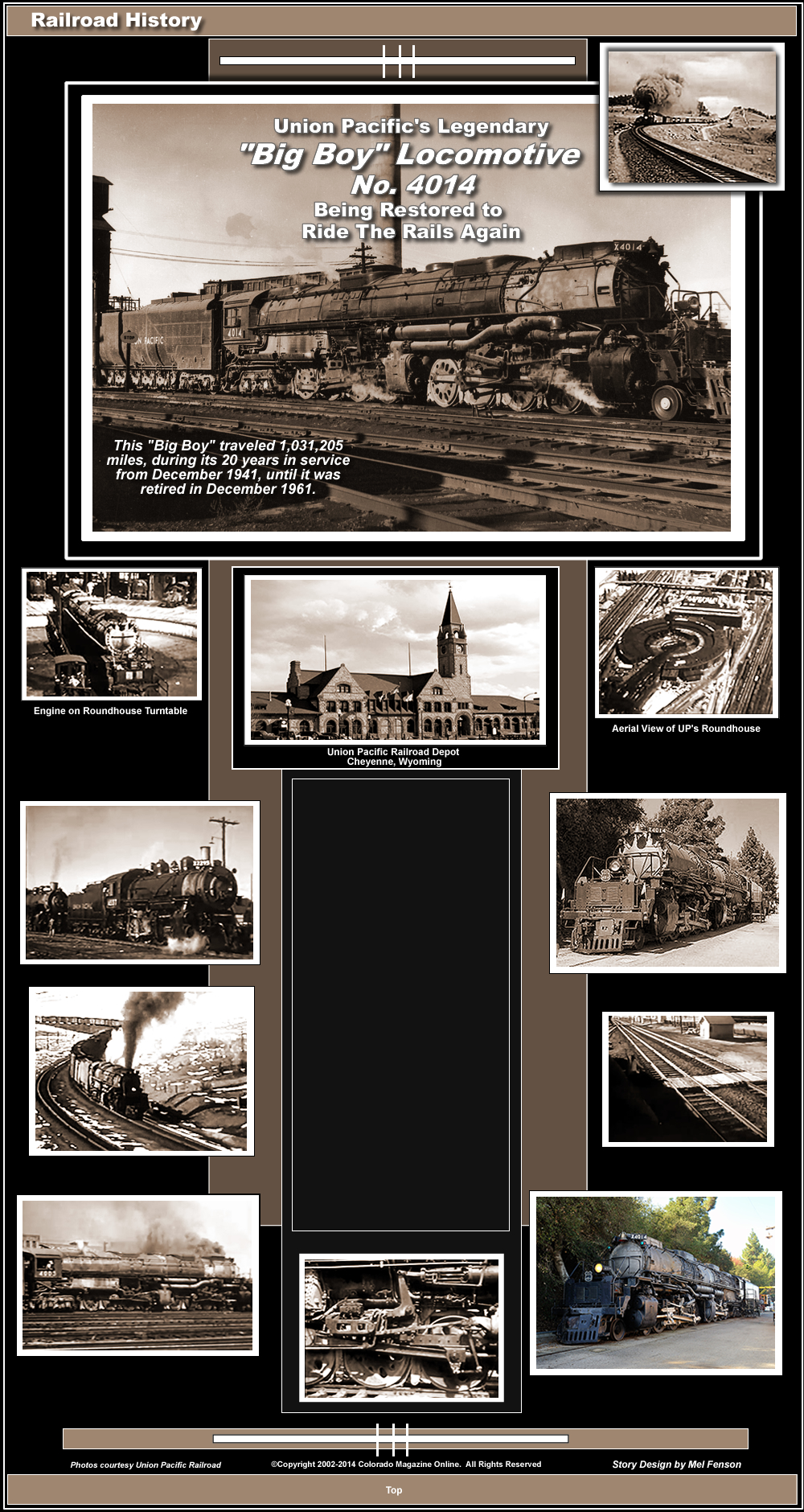

Big Boy No. 4014, is one of the Union Pacific Railroad's 4000-class articulated, coal-fired, steam locomotives that were manufactured by the American Locomotive Company (Alco) in Schenectady, New York between 1941 and 1944.
According to Ed Dickens Jr., Union Pacific's senior manager of heritage operations, the legendary name was coined by an unknown worker who scrawled "Big Boy" in chalk on the front of one of the engines as it was being built and it became the nickname for that class of steam engines.
The Big Boy Locomotives were designed to eliminate the need for doubleheading and helper operations previously employed by Challenger locomotives to handle steep grades. To justify the design and manufacturing of such a locomotive, it would have to be faster and more powerful than slower locomotives like earlier compound 2-8-8-0s that UP tried after World War I. The new class would need to pull long trains at a sustained speed of 60 miles per hour once past mountain grades.
Led by mechanic Otto Jabelmann, the Union Pacific Railroad's design team worked with the American Locomotive Company to determine how to achieve their goals for a more powerful locomotive. They succeeded by making several changes to the Challenger design, which included enlarging the firebox, lengthening the boiler, adding four driving wheels, and reducing the size of the driving wheels from 69 to 68 in.
The Big Boy fleet totaled twenty-five locomotives. They were 132 feet long and weighed 1.2 million pounds. Because the frames were so long, they were articulated (hinged), to allow them to negotiate curves. Without the tender, they had the longest engine body of any reciprocating steam locomotive. The engines were primarily used in UP's Wyoming Division to haul freight over the Wasatch range between Green River, Wyoming and Ogden, Utah.
The Big Boy locomotives were the only locomotives to use a 4-8-8-4 wheel arrangement, consisting of a four-wheel leading truck for stability when going around curves, two sets of eight driving wheels and a four-wheel trailing truck to support the large firebox.
The Big Boy locomotives had large grates to burn the low-quality bituminous coal that was sourced from Union Pacific's own mines in Wyoming. As an experiment, Locomotive 4005 was converted to burn oil, but unlike a similar effort with the Challengers, the conversion was unsuccessful, and the engine was changed back to burn coal.
Built with a wide margin of reliability and safety, the Big Boys could operate smoothly at 80 miles per hour, but they were not intended to be run that fast and normally operated below 60 miles per hour for freight service. Their peak horsepower reached at about 35 mph with an optimal tractive effort at about 10 mph.
Postwar increases of the prices of both coal and labor, compared with the cost-efficiency of diesel-electric motive power resulted in the eventual retirement for the Big Boys. However, they were among the last steam locomotives taken out of service. Toward the end of their career, the Big Boys could still pull more than their rated tonnage of 3,600 tons. Their ratings had been increased several times until they regularly able to pull 4,450 short tons over the Wasatch range.
The last Big Boy run was made on July 21, 1959. Most of the Big Boys were stored in operational condition until 1961. Four engines remained in operational condition at Green River, Wyoming until 1962, when their duties were assumed by diesel locomotives and gas turbine-electric locomotives. Of the 25 Big Boy locomotives manufactured, eight remain. Seven of the eight surviving Big Boys are on static display in railroad museums throughout the United States.
In late 2012, Union Pacific announced that it was interested in acquiring a Big Boy to be restored, then put on a national tour. On July 23, 2013 Union Pacific announced that it had acquired engine number 4014 from The Southern California Chapter of The Railway and Locomotive Historical Society in Pomona, California.
The Union Pacific then began inspecting and preparing to move the locomotive from Pomona to its Steam Shop in Cheyenne, Wyoming. In November 2013, Union Pacific Heritage Fleet Operations director Ed Dickens reported that UP4014 was prepared for the move and that track laying was in progress. On the morning of January 26, 2014, the Big Boy was pulled out of the Los Angeles County Fairplex by a 4,300 horsepower Union Pacific diesel locomotive. The Fairplex property had been the Big Boy's home for 52 years, where it was displayed on a track managed by the Historical Society.
The engine was moved to Union Pacific's West Colton yard in Colton, California. It left there on April 28, 2014, on its journey to Union Pacific's Heritage Fleet Steam Shop in Cheyenne, Wyoming, where it arrived on May 8, 2014.
Under the direction Operations director, Ed Dickens, a UP team has started renovation to restore the 4014 to operating condition. Big Boy No. 4014 had traveled 1,031,205 miles during its 20 years in service. As part of the restoration process, Union Pacific will convert the engine's fuel source from coal to oil. Renovation is expected to take three to five years, after which Big Boy 4014 will go on a national tour.
Edited by Mel Fenson from information obtained from the web.